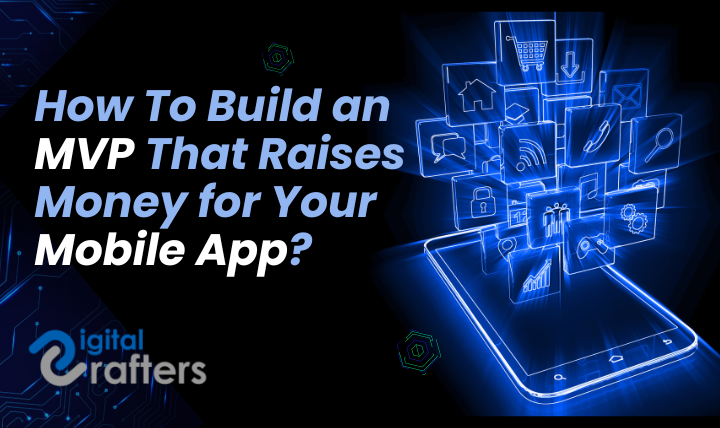
In the modern era, every business requires a mobile app. Mobile applications are considered effective instruments to expand your business potential, whether used for internal processes or customer-facing services.
If we believe the prediction of Statista, by 2023, there will be 299 billion mobile app downloads worldwide. From 275 billion downloads in 2020, this represents a staggering increase of 25 billion in just three years. And it is anticipated that this trend will also continue in the coming years.
There is enormous competition in the mobile app market, so you must develop a mobile app that is unique and can provide your business growth. You must learn how to create a minimal viable product before releasing a fully functional version of our app (MVP). With MVP, you can learn about the app’s basic features and potential, which will help you know whether it is feasible to move forward with and invest in the development of your app.
So, What, exactly, is an MVP? Why is it necessary to develop an MVP? What blunders should you avoid when creating an MVP?
Let’s investigate.
What is a Minimum Viable Product?
MVP in app development has become a sort of mantra. How about we strip the term to the bare bones?
When talking about mobile and web app development, MVP means an initial version of an app that goes public and has enough potential to attract investors and/or start generating revenue. How do you know if your app is an MVP?
Historically, MVPs leaned heavily on minimum. App owners were churning out half-baked applications to check how many users they could attract and how people used the app. For example, Zillow — the most popular real estate app — could get away with something like that:
Today, with thousands of apps released per month (around 600 apps per day on iOS and 3,000 on Android), the focus has shifted to viable. Because the initial impression is everything, you can’t ignore how your app looks in a mobile store and how smooth of a user experience it provides.
Then again, some would say you can design an MVP version of the software by talking to customers, researching social media, and running surveys to collect feedback. One thing they miss with this approach is the product. There’s no product when all you have is customer feedback on an imaginary solution.
How to Build an MVP for Your App?
To create a minimum viable product for your app, there are certain steps to be taken.
Define A Problem Statement
It would help if you always initiated addressing the issue you want to address. You can transcribe it. And, by using an MVP in mobile app development, you can assess its viability.
You can also validate the ideas without development as it is significant to save resources and ensure a requirement in your solution. In the industry, being a professional is beneficial, but you still must learn when the issue you want to address exists.
The first step when you start with how to build your MVP should be to carry out comprehensive market research. This will help us understand what features our target audience is looking for and how they want their apps to be. This will help us create an MVP that meets our users' expectations and identify potential customers or investors interested in what we offer.
Moreover, we need to analyze our competitor's apps, find out what features they are offering, and look at the reviews they have received. This will help us understand what our users expect from our app and what features make our competitors stand out.
Once we have done market research, we will create a wireframe for our app. This will help us visualize how our app would look like and also the features it should have. Once we have all the features listed, we need to prioritize them based on their importance and create a wireframe showing how they would interact. This will help us clearly understand the project's scope and how much effort it would take to develop our app.
We can also use wireframes for prototyping the app and testing it with potential users. This will help us identify any flaws or features that need to be improved before we launch the full version.
Once you’ve identified who your ideal customer is and what their requirements are, you’re ready to define the most important characteristics of your solution. This means identifying the key MVP features of your product. Keep in mind that less is more when it comes down to a minimally viable product. You should concentrate on the most important aspects that satisfy the needs of your targeted market.
Now, you need to develop MVP for your app. MVP includes the development, testing, and optimization of our app.
Before releasing the MVP, you must thoroughly test it and develop it with all of the key features from your wireframe.
Testing is a crucial step in the development of your app.
Your MVP must be created, tested, and launched with beta users.
This will enable you to gather opinions from genuine users and spot any faults with your app.
You can now launch the finished version of our app after testing and optimization. This action will determine your app’s success, making it the most crucial.
Test all the features and ensure all functions are correctly working without issues or kinks.
To promote your app, you should also engage in promotional activities like social media campaigns, influencer marketing, or content marketing.
This will help you grow your user base and raise your profile.
How can an MVP help grow your business, and what are the several benefits of MVP development for fundraising?
Consider the following scenario, you spend months, if not years, developing a dedicated business app and never test it in the market before releasing it.
The outcomes may be devastating and unsatisfactory, as the whole approach may have been incorrect. App developers have been working with MVPs, or Minimum Viable Products, in recent years, utilizing the productive efforts of business firms.
You take too much risk when you invest in full-fledged app development. Most of your funding has been spent on developing your product, and you need to know if it’s market-ready or functionally accurate.
And by discovering flaws in the latter stages, you need more time to improve. However, with an MVP, you may get an alpha version of your app produced for a bit of cost and gain maximum advantage.
One of the primary benefits of creating an MVP is that it will reveal if there is a market for your app idea. It would demonstrate how crowded your niche market is, how your competitors are performing, and what you need to do to stand out.
You also know where you went wrong with your software and its parts. When you test your concepts, you can produce a far more optimized final app.
Most businesses skip this phase, yet early input is critical. You must know if your app is on the right track in development before it’s too late to pull the plug. With early feedback, you can quickly pivot, close gaps, address concerns, and make your app more secure.
In conclusion
Creating an MVP is an important step in the fundraising process for your mobile app. You can build a product that will appeal to investors and help you secure the cash you need to launch your app if you follow my advice.
Furthermore, successful companies such as Airbnb, Uber, and WhatsApp began as MVPs and have since become the most successful.
So, don’t let minor details prevent you from attracting investors for your minimum viable product.
